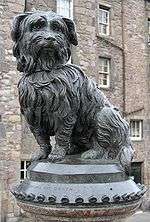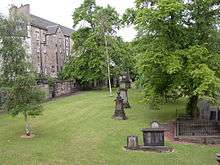Greyfriars Bobby
|
This statue of Bobby sits at the corner of Edinburgh's Candlemaker Row and George IV Bridge, and is a Category A listed building | |
| Breed | Skye Terrier |
|---|---|
| Born | c. 1855 or 1856 |
| Died |
14 January 1872 (aged 16) Edinburgh, Scotland |
| Resting place | Greyfriars Kirkyard |
| Owner | John Gray |
| Awards | Key to the City of Edinburgh |
Greyfriars Bobby was a Skye Terrier who became known in 19th-century Edinburgh for supposedly spending 14 years guarding the grave of his owner until he died himself on 14 January 1872. The story continues to be well known in Scotland, through several books and films, and a prominent commemorative statue and nearby graves act as a tourist attraction.
Traditional view
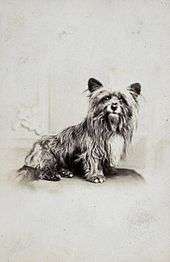
The best-known version of the story is that Bobby belonged to John Gray, who worked for the Edinburgh City Police as a night watchman. When John Gray died he was buried in Greyfriars Kirkyard, the graveyard surrounding Greyfriars Kirk in the Old Town of Edinburgh. Bobby then became known locally, spending the rest of his life sitting on his master's grave.[1][2]
In 1867 Lord Provost of Edinburgh, Sir William Chambers — who was also a director of the Scottish Society for the Prevention of Cruelty to Animals — paid for Bobby's licence, and gave the dog a collar now in the Museum of Edinburgh.[2][3]
Bobby is said to have sat by the grave for 14 years.[1][2][3][4] He died in 1872[3][4] and was buried just inside the gate of Greyfriars Kirkyard, not far from John Gray's grave.[2]
A year later, the English philanthropist Lady Burdett-Coutts was charmed by the story and had a drinking fountain topped with Bobby's statue (commissioned from the sculptor William Brodie) erected at junction of George IV Bridge and Candlemaker Row (opposite the entrance to the churchyard) to commemorate him.[4]
Several books and films have since been based on Bobby's life, including the novel Greyfriars Bobby (1912) by Eleanor Atkinson and the films Greyfriars Bobby (1961) and The Adventures of Greyfriars Bobby (2006).
Alternative views
The accuracy of stories of Greyfriars Bobby has been challenged many times — for instance, in books by Forbes Macgregor Greyfriars Bobby: The Real Story at Last,[5] by Jan Bondeson Greyfriars Bobby: The Most Faithful Dog in the World.[6] and by Richard Brassey in "Greyfriars Bobby The Most Famous Dog in Scotland".[7]
Questions about the story's accuracy are not new. In a newspaper article in The Scotsman, "Greyfriars Bobby A Dog's Devotion" (11 August 1934), Councillor Wilson McLaren responds to contemporary questions about the accuracy of the stories by describing his own conversation, in 1871, with "Mr Traill" of "Traill's Coffee House" in relation to the dog he himself was then feeding, reassuring readers about the story Mr Traill had given him, and describing responses in 1889 to questions about the story's accuracy.[8] A sense of the difficulty of determining accuracy is gained from two opposing letters to The Scotsman newspaper on 8 February 1889 (part of the debate referred to by McLaren), both from people claiming close links to Greyfriars Kirk, both claiming to have known of the dog personally, but with opposing views over the accuracy of stories.[9]
A common discussion is over which of two people named John Gray was the real owner of Bobby (one being a night watchman and the other a farmer).[3] In Councillor McLaren's account Mr Traill in 1871 had spoken about John Gray the farmer.[8]
Jan Bondeson's book advances the view that fundamental facts about the dog and its loyalty are wrong. Bondeson states as background that in 19th-century Europe there are over 60 documented accounts of graveyard or cemetery dogs. These were stray dogs which were fed by visitors and curators to the point where the dogs made the graveyards their home, people coming to believe that they were waiting by a grave, and the result being that the dog was looked after. Bondeson claims that after an article about Bobby appeared in The Scotsman, visitor numbers to the graveyard increased, which supposedly created a commercial benefit for the local community.[6] Bondeson also believes that in 1867 the original Bobby died and was replaced with a younger dog, and that this explains Bobby's supposed longevity.[6]
Parallels
The story of Greyfriars Bobby has similarities to many others from around the world.
In memory
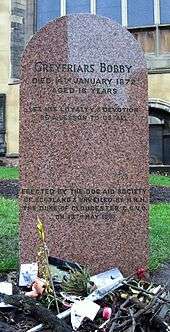
The Greyfriars Bobby Fountain in Edinburgh includes a lifesize statue of Greyfriars Bobby created by William Brodie in 1872. This was paid for by a local aristocrat, Baroness Burdett-Coutts and unveiled on 15 November 1873.[10][4] It stands near the south (main) entrance to Greyfriars Kirkyard. The monument is Edinburgh's smallest listed building. Originally built as a drinking fountain, it had an upper fountain for humans and a lower fountain for dogs. This had the water supply cut off (as with all Edinburgh's drinking fountains) around 1975 amidst health scares.[4] Both basin areas were infilled with concrete soon after. After being daubed with yellow paint, allegedly by students, on General Election night in 1979, and being hit by a car in 1984, restoration became critical. The monument was subsequently fully restored under the supervision of Edinburgh District Council in 1985. The entire base is newly carved but emulates the original exactly.[11] A plaque on the base reads "A tribute to the affectionate fidelity of Greyfriars Bobby. In 1858, this faithful dog followed the remains of his master to Greyfriars Churchyard and lingered near the spot until his death in 1872. With permission erected by the Baroness Burdett-Coutts". Inscribed on the statue is "Greyfriars Bobby, from the life just before his death" and "W.H. Brodie Sc RSA 1872".[4] In recent years a tour company which offers free tours has encouraged thousands of tourists to rub Bobby's nose 'for luck', erroneously claiming it to be an old Edinburgh tradition. This has led to the statue's nose becoming shiny and worn. This practice is an act of unwitting vandalism which threatens the fabric of this historic monument.
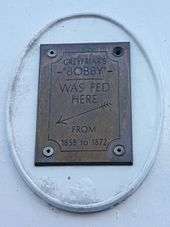
A red granite stone was erected on Bobby's grave by The Dog Aid Society of Scotland, and unveiled by the Duke of Gloucester on 13 May 1981. Since around 2000 this has been treated in a shrine-like manner, with sticks (for Bobby to fetch) frequently left and occasionally dog toys, flowers, etc. The monument reads: "Greyfriars Bobby – Died 14 January 1872 – Aged 16 years – Let his loyalty and devotion be a lesson to us all."
Books and films directly about Bobby
- The 1912 book Greyfriars Bobby by Eleanor Atkinson embellished the story and made John Gray a shepherd, known as "Auld Jock".[12] The 1961 Walt Disney film Greyfriars Bobby: The True Story of a Dog was based on this book.[13]
- The Illustrated True Story of Greyfriars Bobby by John Mackay.
- The Adventures of Greyfriars Bobby, another film, was released in the UK in February 2006 starring James Cosmo and Christopher Lee (released elsewhere in 2005 under the alternative title Greyfriars Bobby).[14] The Edinburgh Castle scenes in this film were actually shot at Stirling Castle. Many expressed reservations that a West Highland White Terrier was cast as Bobby, and that new characters were added while one of the major characters in Bobby's life, John Traill, was omitted.[15]
Other references in popular culture
- Challenge to Lassie (1949), is an earlier film based on Atkinson's book, replacing Bobby with Lassie.[16]
- The 1945 film The Body Snatcher, has an oblique reference to Bobby. The title character, played by Boris Karloff, while seeking to dig up a corpse in Greyfriars Kirkyard, encounters a dog (named "Robbie") guarding the grave. The dog is killed.[17]
- There is an anachronistic reference to the character in the 2010 British black comedy Burke and Hare.[18]
See also
- Bobbie, the Wonder Dog
- Dog on the Tuckerbox
- Fido (dog)
- Hachikō, the faithful dog commemorated by a statue at Shibuya, Tokyo
References
- 1 2 greyfriarsbobby.co.uk (11 February 2013).
- 1 2 3 4 Education Scotland website (11 February 2013).
- 1 2 3 4 Edinburgh Museums and Galleries website (11 February 2013).
- 1 2 3 4 5 6 Edinburgh Museums (monuments) website (11 February 2013)
- ↑ Macgregor, Forbes "Greyfriars Bobby: The Real Story at Last" Steve Savage Publishers Limited, 2nd Revised edition, (2002), ISBN 978-1904246008
- 1 2 3 Jan Bondeson, Greyfriars Bobby: The Most Faithful Dog in the World, Amberley Publishing, 2011, ISBN 978-1445607627
- ↑ Brassey, Richard "Greyfriars Bobby" Orion Childrens, (2010), ISBN 978-1444000573
- 1 2 The Scotsman, 11 August 1934
- ↑ The Scotsman, 8 February 1889
- ↑ Buildings of Scotland; Edinburgh by Colin McWilliam
- ↑ Edinburgh Council Conservation Grant records
- ↑ Eleanor Atkinson. Greyfriars Bobby at Project Gutenberg.
- ↑ Douglas Brode (2004). From Walt to Woodstock: How Disney Created the Counterculture. University of Texas Press. pp. 194–196. ISBN 0-292-70273-6.
- ↑ The Adventures of Greyfriars Bobby: IMDB.com website.
- ↑ Stirling Castle location, The Adventures of Greyfriars Bobby: BBC.co.uk website.
- ↑ Hanson, Patricia King, ed. (1999). AFI Catalog of Motion Pictures Produced in the United States. University of California Press. p. 400. ISBN 0-520-21521-4.
- ↑ Gregory W. Mank (2009). Bela Lugosi and Boris Karloff: The Expanded Story of a Haunting Collaboration. McFarland. pp. 481, 504. ISBN 978-0-78645-472-3.
- ↑ Neil Smith (29 October 2010). "Burke and Hare: You won't die laughing...". Total Film. Retrieved 12 September 2013.
External links
| Wikimedia Commons has media related to Monuments to Greyfriars Bobby. |
- Greyfriars Kirkyard Trust
- The Adventures of Greyfriars Bobby (2005) Film website.
- Greyfriars Bobby Statue Location at Waymarking.com website.
